Resume Optimization Tips: Crafting a Winning Document for Career Success
In today’s competitive job market, a well-optimized resume can be the key to unlocking doors to exciting career opportunities. Your resume is not just a list of experiences; it’s a powerful marketing tool that showcases your skills, achievements, and potential contributions to prospective employers. In this comprehensive guide, we’ll explore ten essential resume optimization tips to help you create a compelling document that stands out from the crowd and propels your career forward.
1. Tailor Your Resume for Each Application
Gone are the days of one-size-fits-all resumes. Customize your resume for each job application by aligning it with the specific requirements of the position. Highlight the skills, experiences, and keywords mentioned in the job description to demonstrate your suitability for the role.
2. Optimize Formatting for Clarity
A well-organized and visually appealing resume is more likely to capture the attention of hiring managers. Utilize clear headings, bullet points, and consistent formatting to create a professional and easy-to-read document. Choose a clean font and maintain a balanced layout to enhance overall visual appeal.
3. Craft a Compelling Professional Summary
Begin your resume with a concise and impactful professional summary. This section serves as your elevator pitch, providing a snapshot of your key skills, experiences, and career objectives. Make it attention-grabbing and tailored to the specific job you’re applying for.
4. Quantify Achievements with Numbers
Employers value measurable achievements. Wherever possible, use quantifiable metrics to highlight your accomplishments. Whether it’s increasing sales by a certain percentage, managing a team of a specific size, or completing projects ahead of schedule, numbers add credibility to your achievements.
5. Prioritize Relevant Work Experience
Highlight your most relevant work experiences, focusing on accomplishments and responsibilities that directly relate to the job you’re pursuing. Tailor your descriptions to emphasize how your past experiences have prepared you for the challenges of the new role.
6. Showcase a Diverse Skill Set
Create a dedicated skills section that showcases both hard and soft skills. Include technical proficiencies, languages, certifications, and any other relevant competencies. This section helps employers quickly identify the strengths that make you a suitable candidate.
7. Use Dynamic Action Verbs
Begin bullet points with powerful action verbs to make your accomplishments more dynamic and engaging. Strong verbs convey a sense of initiative and impact. Avoid generic language and opt for specific, results-oriented descriptions.
8. Incorporate Industry-Specific Keywords
Many employers use Applicant Tracking Systems (ATS) to screen resumes. To ensure your resume passes through these systems successfully, incorporate industry-specific keywords related to your field. Use terms and phrases found in the job description to enhance visibility.
9. Highlight Education and Certifications
Present your educational background and any relevant certifications. Include details such as the institution’s name, graduation date, and any academic honors or awards. This section provides context for your qualifications and adds credibility to your profile.
10. Leverage Online Presence
In the digital age, your online presence matters. Consider adding links to your professional social media profiles, such as LinkedIn or GitHub, if they are well-maintained and relevant to your career. Ensure that your online presence aligns with the professional image presented in your resume.
Frequently Asked Questions (FAQs) About Resume Optimization
- Why is it important to tailor my resume for each job application?
Tailoring your resume demonstrates a genuine interest in the specific role and shows that you’ve carefully considered how your skills align with the job requirements. It increases your chances of standing out to hiring managers. - How can I optimize the formatting of my resume for clarity?
Optimize formatting by using clear headings, bullet points, and a consistent layout. Choose a professional font, maintain white space, and ensure a visually appealing design to enhance readability. - What should be included in a compelling professional summary?
A compelling professional summary should provide a snapshot of your key skills, experiences, and career objectives. It should be tailored to the specific job and capture the attention of hiring managers within a few sentences. - Why is it beneficial to quantify achievements with numbers on a resume?
Quantifying achievements with numbers adds specificity and credibility to your accomplishments. It provides tangible evidence of your impact and helps hiring managers understand the scope of your contributions. - How do I prioritize and showcase relevant work experience on my resume?
Prioritize relevant work experiences by emphasizing accomplishments and responsibilities that directly relate to the job you’re applying for. Tailor your descriptions to highlight skills and experiences most relevant to the position. - What’s the importance of showcasing a diverse skill set in a dedicated section?
A dedicated skills section allows you to showcase both hard and soft skills quickly. This section helps hiring managers identify the key strengths that make you a suitable candidate for the position. - Why is it recommended to use dynamic action verbs in resume bullet points?
Using dynamic action verbs adds impact and energy to your resume. Strong verbs convey a sense of initiative and achievement, making your contributions more compelling to potential employers. - How can I incorporate industry-specific keywords effectively?
Incorporate industry-specific keywords by carefully reading the job description and using relevant terms and phrases. This helps your resume pass through Applicant Tracking Systems (ATS) and increases visibility to employers. - Should I include links to my online profiles in my resume?
Including links to your professional online profiles, such as LinkedIn or GitHub, can be beneficial if they are well-maintained and relevant to your career. Ensure that your online presence aligns with the professional image presented in your resume. - How often should I update my resume?
Regularly update your resume, especially after acquiring new skills, completing projects, or achieving milestones in your career. Keeping it current ensures that you present the most accurate and relevant information to potential employers.
Remember, addressing these frequently asked questions will not only enhance your understanding of resume optimization but will also guide you in creating a document that effectively communicates your qualifications and experiences to prospective employers.
Conclusion
Your resume is your personal marketing document, and its effectiveness can significantly impact your career trajectory. By implementing these ten resume optimization tips, you can create a powerful and tailored document that not only showcases your qualifications but also resonates with hiring managers. Remember, the goal is to present yourself as the ideal candidate for the job, and a well-optimized resume is your ticket to success in a competitive job market.

As an experienced career coach and writer, I’ve dedicated myself to empowering job seekers worldwide through JobSearchScore. With a passion for helping individuals across the complexities of the job market, I curate invaluable resources, offer expert advice, and provide actionable strategies to support career advancement and success.




